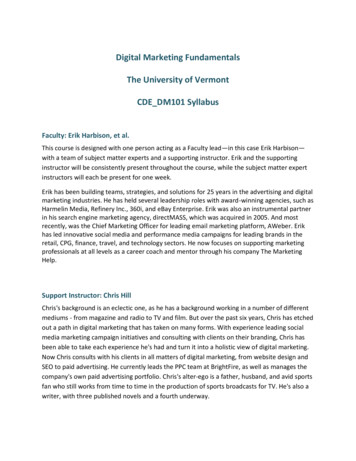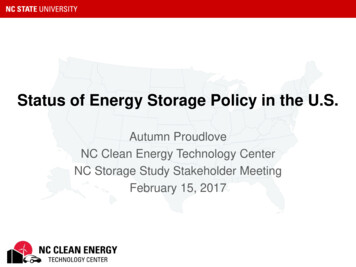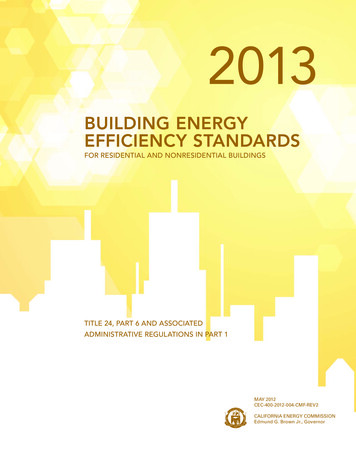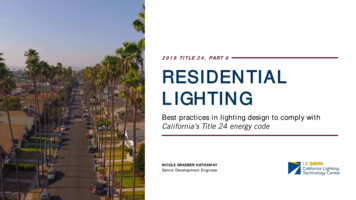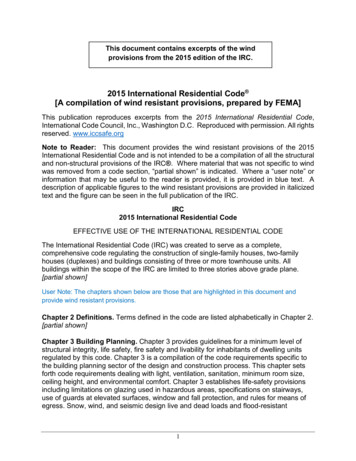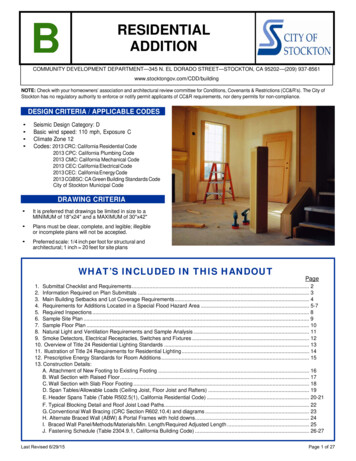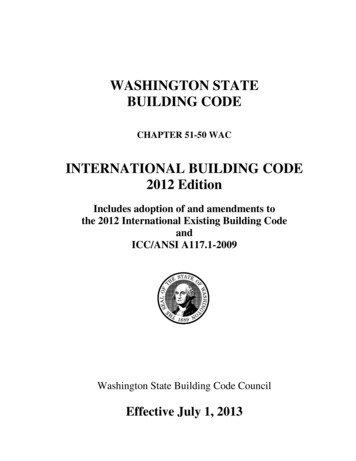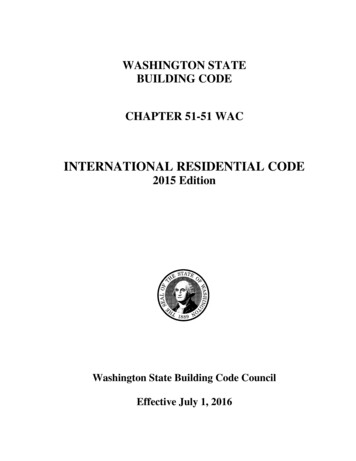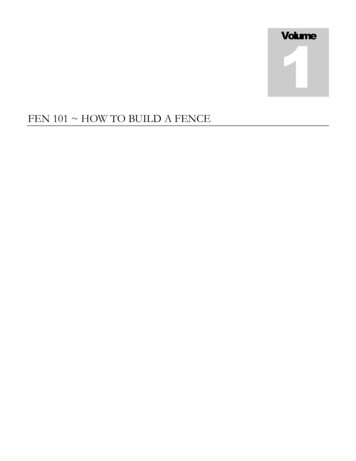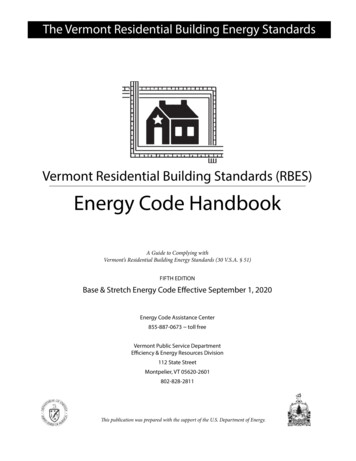
Transcription
The Vermont Residential Building Energy StandardsVermont Residential Building Standards (RBES)Energy Code HandbookA Guide to Complying withVermont’s Residential Building Energy Standards (30 V.S.A. § 51)FIFTH EDITIONBase & Stretch Energy Code Effective September 1, 2020Energy Code Assistance Center855-887-0673 toll freeVermont Public Service DepartmentEfficiency & Energy Resources Division112 State StreetMontpelier, VT 05620-2601802-828-2811This publication was prepared with the support of the U.S. Department of Energy.
ContentsHow to Use This Handbook. 1When to Consult the Handbook. 1Overview. 1What’s New in RBES 2020?. 1If You Need Help. 2Introduction: The Vermont Residential Standards (RBES) Energy Code.4What Buildings Must Comply?. 4What Buildings Are Exempt?. 4The Basic Steps for Meeting the Energy Code. 5Compliance Methods. 5Stretch Code. 6Technical Assistance with Energy Code Requirements. 6Residential Energy Code Updates. 6Chapter 1:Rules for Compliance.8Chapter 2:Basic Requirements. 12Chapter 3 :Ventilation and Combustion Safety Requirements. 34Chapter 4 :Existing Homes: Additions, Alterations, and Repairs. 441.1 Builder’s Responsibilities. 81.2 Buildings That Must Comply. 81.3 Exempt Buildings. 91.4 Owner/Builder Special Provision. 91.5 Act 250 Provisions. 101.6 Penalty for Not Complying with the Residential Energy Code. 102.1 Building Envelope. 132.2 Vapor Retarders. 212.3 Materials and Equipment Information. 262.4 Heating and Cooling. 262.5 Service (Potable) Water Heating. 302.6 Electrical. 312.7 Dampers. 312.8 Lighting. 313.1 Ventilation . 343.2 Combustion Safety. 404.1 Exceptions. 444.2 Compliance. 454.3 Prescriptive Compliance for Additions. 464.4 U-Factor Alternative Compliance for Additions. 47
Chapter 5 :The Package-Plus-Points Prescriptive Compliance Method. 48Chapter 6 :The REScheck Software Compliance Method.64Chapter 7 :The Home Energy Rating Compliance Method.68Chapter 8 :Certification.745.1 When to Use the Packages-Plus-Points Method. 485.2 Meeting BASE Code Using the Packages-Plus-Points Method. 495.3 Meeting STRETCH Code Using the Packages-Plus-Points Method. 535.4 Building assembly and window examples. 536.1 How the Software Method Works. 656.2 Using REScheck Software. 656.3 How to Access the REScheck Software. 667.1 How the Home Energy Rating Method Works. 687.2 Advantages of the Home Energy Rating Method. 697.3 The Home Energy Rating. 707.4 Minimum Thermal Envelope Efficiency Levels for HERS Compliance. 707.5 HERS Compliance Process. 728.1 Types of Certification. 748.2 The ‘Vermont Residential Building Energy Standards Certificate’. 748.3 The ‘Vermont Owner/Builder Disclosure Statement’. 78Appendix A: Additional Stretch Code Requirements.81A.1 Package Plus Points. 81A.2 Home Energy Rating Compliance Method. 81A.3 Air Leakage Testing. 81A.4 Electric Vehicle (EV) Charging. 82A.5 Solar Ready Zone. 82A.5a Construction Document Requirements for Solar Ready Zone. 83A.5b Solar-Ready Zone Area. 83A.5c Obstructions. 83A.5d Roof Load Documentation. 83A.5e Interconnection Pathway. 84A.5f Electrical Service Reserved Space. 84Appendix B: Default Values.85Appendix C: Guidelines for Calculations.86C.1 When to Perform Calculations. 86C.2 How to Define the Building Envelope. 86C.3 How to Calculate the Glazing Percentage. 87C.4 Understanding Thermal Values. 90C.5 How to Calculate Average R-values and U-factors. 90C.5b Average U-factors . 91Appendix D: Vermont Resources for Energy Efficiency & Utility Services.93Appendix E: Residential Building Energy Standards Legislation.96Appendix F: Definitions.97
The Vermont Residential Building Energy StandardsHow to Use This HandbookThis Handbook contains information explaining the key requirements of Vermont’s “Residential Building Energy Standards”(“RBES” or the “Energy Code”) for residential construction. Each chapter is divided into sections. For instance, a reference to“Section 2.3” indicates the third section of Chapter 2. Further divisions of a section are labeled with a letter (e.g., 2.3a, 2.3b,etc.). Tables and figures are numbered sequentially within each chapter. For example, the first table in Chapter 3 is Table 3-1, thesecond table is Table 3-2, etc.This Handbook also includes references to sections in the RBES code language.Visit -energy-standards for a free viewable copy of the full RBES.A printed copy can be obtained by calling the Energy Code Assistance Center at 855-887-0673, toll free.When to Consult the HandbookWhat’s Newin RBES2020?There are four main situations that call for a review ofthis Handbook:1. When making additions, alterations, renovations orrepairs to existing homes.2. During the new construction design stage, reviewthe requirements up front. It will be easier and lessexpensive at this stage to make any modificationsneeded to ensure compliance.3. In the event of new construction design changes,review whether the home still complies when thereare changes. This will ensure that there are nosurprises upon completion.4. Upon completion, State law requires every Vermontbuilder to certify that the home complies with theEnergy Code as built, altered or repaired.Major changes from RBES 2015 include but are not limited to:1.Clarification of definitions and other language2.Insulation and fenestration criteria3. Base Code: Prescriptive packages plus required pointsfrom a list of options based on the house size Stretch Code: Similar package plus points approach as basecode, but with more stringent prescriptive packages andmore points requiredAir Leakage Testing Blower door testing by a certified tester is now requiredfor both Base and Stretch Code4.Electric resistance heating equipment is prohibited exceptunder certain stringent conditions5.Electric vehicle charging (Base & Stretch)– minimum charging infrastructure now required6.HERS rating values include an adjustment factor thataccounts for building size and shape in the calculation (Base& Stretch)7.Solar Ready required for Stretch CodeFifth Edition September 2020
The Vermont Residential Building Energy Standards Introduction: Vermont Residential Building Energy Standards — summarizes the key features of the Energy Code. Chapter 1: Rules for Compliance — explains in detail which buildings must comply and which are exempt. Chapter 2: Basic Requirements — explains in detail the mandatory requirements that all buildings must meet (aside fromadditional Prescriptive or Performance requirements). Chapter 3: Ventilation and Combustion Safety Requirements — discusses the importance of indoor air quality andhow to achieve it. Chapter 4: Existing Homes: Additions, Alterations, and Repairs — explains requirements for additions, alterationsand repairs. Chapter 5: The Package Plus Points Compliance Method – explains how to meet the Energy Code via the Package PlusPoints compliance pathway. This method is similar to the Prescriptive Compliance Method from previous code cycles butwith key changes. Chapter 6: The REScheck Software Compliance Method – explains how REScheck can be used to check forcompliance. Chapter 7: The Home Energy Rating Compliance Method – explains how Energy Rating Index or Home Energy RatingSystem (“ERI” or ”HERS”) can be used for compliance. Chapter 8: Certification — specifies how to accurately certify compliance with the Energy Code.The Appendices include the minimum requirements for Stretch code, definitions and clarifications of terms used in thisHandbook, default R-values and U-factors, guidelines for calculations, and Vermont-specific resources for builders.If You Need HelpThe Energy Code Assistance Center (ECAC) provides free technical assistance. Call toll-free: 855-887-0673.Fifth Edition September 2020
IntroductionThis chapter summarizes the key featuresof the VermontThe Vermont ResidentialBuilding Energy Standards(RBES) Energy CodeResidential BuildingEnergy Code onSeptember 1, 2020.The Vermont Residential Building Energy Standards (“RBES”, the “Residential Energy Code” or simply the “Energy Code”) initially waspassed by the Vermont legislature in May 1997. It is a minimum standard of energy efficiency that has applied to virtually all new residentialconstruction in Vermont since July 1, 1998 with updates in 2006, 2011, 2015, and 2020. The 2020 Energy Code is based on the 2015 VermontResidential Building Energy Standards, which are based on the International Energy Conservation Code (IECC). The 2020 RBES alsoincludes select IECC 2018 and 2021 updates with additionally stringent Vermont energy efficiency requirements.What Buildings Must Comply? Detached one- and two-family dwellings. Multi-family and all other residential dwellings three stories or fewer in height. Additions, alterations, renovations and repairs to existing residential buildings. Factory-built modular homes not on a permanent chassis. Residential buildings commencing construction on or after September 1, 2020 must comply with this Energy Code. Residential buildingsfor which construction commenced before September 1, 2020, if not complying with this Code, must comply with the previous versionof RBES. Act 250 projects commencing construction on or after September 1, 2020 must comply with the 2020 Stretch Code. In towns that require a certificate of occupancy (COO), a RBES certificate is required before the COO can be issued.This is a summary; see Chapter 1 for details.What Buildings Are Exempt? Commercial and high-rise residential buildings (over three stories); however, these must meet the Commercial Building Energy Standards(“CBES”). Residential portions of a mixed-use building that is three stories or less must meet the Residential Energy Code. Residentialportions of mixed-use buildings include the living spaces in the building and the nonliving spaces in the building that serve only theresidential users such as common hallways, laundry facilities, residential management offices, community rooms, storage rooms, andfoyers. Mobile homes on a permanent chassis (except for site-built components such as conditioned basements or crawl spaces). Buildings or additions with very low energy use (those designed for a peak energy use of less than 3.4 Btu/hr. [1 Watt] per square footof floor area). Unconditioned buildings. Hunting camps or summer camps. Note that summer camps are only exempt if constructed for non-winter occupation with only abiomass (wood) or other on-site renewable heating system. Individual provisions of the code may be exempted when applied to historic buildings if the provision would threaten, degrade ordestroy the historic form, fabric or function of the building. (See Chapter 4)This is a summary; see Chapter 1 for details.Introduction: The Vermont Residential Energy Code3
The Basic Steps for Meeting the CodeThe Vermont Residential Energy Code encompasses two requirements:1) A technical requirement (i.e., minimum standards for energy-efficient buildingcomponents and construction practices) and2) A certification requirement for reporting compliance. It is one of the few energycodes in the country in which the builder may self-certify compliance.The law recognizes that it is the builder’s responsibility to understand the Residential Energy Code,to build to the minimum technical efficiency standards, and then to certify (on a one-page form) thatthe building complies with the law. Plan reviews or final inspections may be required by buildingcode officials1. However, an air leakage test by a certified inspector is now required for all homes.The whole process can be summarized as follows:1. Determine whether you need to comply (Chapter 1);2. Follow the Basic Requirements (Chapter 2);3. Follow the minimum Ventilation and Combustion Safety Requirements(Chapter 3);4. For existing homes, follow the requirements for additions, alterations,renovations and repairs (Chapter 4).5. Select and complete the Compliance Method that works best for you, complete a blower doorair leakage test (Chapters 5-7); and6. Fill out, file and post the required compliance certificate (Chapter 8).Compliance MethodsIn order to comply with the Residential Energy Code, a home as built must meet all the BasicRequirements, Ventilation & Combustion Safety Requirements and the Prescribed Requirementsusing one of the compliance methods. Additions, alterations, renovations and repairs must meetthe Existing Homes requirements pertaining to the portion(s) of the home affected.The Energy Code is both simple and flexible in the ways a home can meet the technical requirements.There are three methods that can be used to comply. You select the one that works best for yourdesign. There are three options that describe the thermal and efficiency values that are necessaryto meet the minimum standards of the Energy Code. These vary in simplicity of use, as well as inthe level of efficiency above the minimum standards that must be achieved. In general, the simplestmethods specify the highest levels of efficiency, while the more complex methods are closest to theminimum efficiency standard of the Energy Code. The three compliance methods are:The simplest approach (the “Package Plus Points” approach) allows you toPrescriptive Methodincorporate a prescribed set of features. Minimal calculations. (See Chapter 5.)REScheck Software Method Use your computer with REScheck software to easily analyze almost any designand determine whether any modifications are needed to meet the Base Code.Cannot be used for Stretch Code compliance. (See Chapter 6.)Home Energy Rating Method This approach gives full credit for air tightness, efficient heating, cooling and domesticwater heating, and solar orientation. A certified Energy Rater is required to completethis approach. (See Chapter 7.)14While the Residential Energy Code does not require inspections by code officials, it does not eliminate inspections related to Act 250projects, spot checks for enforcement of other applicable codes, or inspections required by state or local codes.Introduction: The Vermont Residential Energy Code
The Residential Energy Codeis both simple and flexible inthe ways a home can meet thetechnical requirement. Thereare three methods that can beStretch CodeThe Residential Energy Code includes two levels of stringency: Base Code and Stretch Code. The BaseCode is the standard level most everyone must meet (see “Which Buildings Must Comply” above).The Stretch Code is the required level for all Act 250 projects and in Vermont towns that choose toimplement a higher energy standard. In general, the Stretch Code includes the following:used to comply. You select the Greater emphasis on continuous insulation on above grade walls;one that works best for your Stronger preference for balanced (fresh air) ventilation systems; anddesign. Higher points requirement to achieve compliance (see Table 5-5 Required Points by Building Sizefor Stretch Code and Table 5-6 Points Options for Stretch Code by Component)Technical Assistance with Energy Code RequirementsTechnical assistance with the Residential Energy Code is available at no charge. Contact the EnergyCode Assistance Center (ECAC) at 855-887-0673 (toll free). ECAC services include: Workshops for builders on how to comply with the Vermont Residential Energy Code.Handbooks, forms, software and other Energy Code-related materials.Professional advice on how to easily meet the Energy Code.Information about state-of-the-art construction techniques and building details.Referral to energy-efficiency programs.Sources for energy-efficient products.Customized workshops and presentations on energy-efficient building practices.Residential Energy Code UpdatesThe statute that governs the Vermont Residential Energy Code provides for regular review and updatesto the provisions in the Energy Code. The review of the Residential Energy Code is administered bythe Vermont Department of Public Service (PSD). Please address all comments and inquiries to:Vermont Public Service DepartmentEfficiency & Energy Resources Division112 State StreetMontpelier, Vermont 05620-2601802-828-2811E-CALL Hotline855-887-0673The E-CALL Hotline is staffed from 8 a.m.to 5 p.m. Monday through Friday. A voicemail is available at all other times. Call forfree assistance with any Code-related questions or concerns you may have.Introduction: The Vermont Residential Energy Code5
This chapter discusses: The builder’sresponsibilitiesunder the VermontResidential EnergyCode. What the ResidentialEnergy Code does anddoes not cover.Chapter 1Rules for ComplianceSection 1.1Builder’s ResponsibilitiesUnder the Vermont Residential Energy Code, it is your responsibility as a builder to determinefor each residential building project:1. Whether the building is required to meet the minimum technical requirements of the EnergyCode, and2. Whether a RBES Certificate must be completed and filed in order to meet certificationrequirements (a Certificate is required unless the building is exempt as specified in Section1.3).Section 1.2Buildings That Must ComplyThe following buildings must meet both the technical and the certification requirements of the Vermont Residential Energy Code: Chapter 1: Rules for ComplianceDetached one- and two-family dwellings.Multi-family and other residential buildings three stories or fewer in height andresidential portion of a mixed-use building 3 stories or fewer in height.Additions, alterations, renovations and repairs (further detail in Chapter 4).Factory-built modular homes not subject to Title VI of the NationalManufactured Housing Construction & Safety Standards Act of 1974 (i.e., homesnot on a permanent chassis).Site built components (such as conditioned basements or crawlspaces) of mobilehomes not subject to RBES must comply.7
Section 1.3Exempt BuildingsThe following buildings are exempt from both the technical and the certification requirementsof the 2020 Vermont Residential Energy Code: Commercial buildings, portions classified as commercial, or high-rise residential(over three stories). These buildings must comply with the 2020 CommercialBuilding Energy Standards (CBES).Mobile homes subject to Title VI of the National Manufactured HousingConstruction & Safety Standards Act of 1974 (i.e., single- and double-wide homeson a permanent chassis). Site-built components such as conditioned basementsor crawl spaces are not exempt and must be constructed to meet the ResidentialEnergy Code.Buildings or additions with very low energy use: Buildings or additionsdesigned for a peak energy use of less than 3.4 Btu/h (1 Watt) per square foot offloor area. (Any occupied building intended to be heated and lived in will notmeet this exemption.)Unconditioned buildings that are neither heated nor cooled.Hunting camps and summer camps. Note that summer camps are only exemptif constructed for non-winter occupation with only a biomass (wood) or other onsite renewable heating system.Individual provisions of the code may be exempted when applied to historicbuildings if the provision would threaten, degrade or destroy the historic form,fabric or function of the building. (See Chapter 4)Unaltered portions of an existing building or building system do not need tocomply.Section 1.4Owner/Builder Special Provision“Owner/builder” projects are exempt from the technical requirements of the Code, but theowner/builder must meet certification requirements by completing and filing a Vermont Owner/Builder Disclosure Statement at the Town Clerk’s Office where the home is located and with theVermont Public Service Department. To qualify for this provision, all of the following criteriamust be met:1. The owner must be the person in charge of construction (i.e., the “general contractor”),directing the details of construction and the selection and installation of materials.2. The owner must live in the building.3. The owner must evaluate whether the home meets the Residential Energy Code.4. Depending on whether the home meets the technical requirement of the Energy Code, theowner must complete one of two documents: either the Vermont Residential Building EnergyStandards Certificate if the home meets the technical requirement, or the Vermont Owner/Builder Disclosure Statement if it does not. (See Chapter 8.)8Chapter 1: Rules for Compliance
5. Before entering into a binding purchase and sale agreement, the owner must disclose inwriting (using the Vermont Owner/Builder Disclosure Statement) to a prospective buyer thenature and extent of any non-compliance with the Residential Energy Code.Section 1.5Act 250 ProvisionResidential buildings commencing construction on or after September 1, 2020 must complywith this 2020 Energy Code. Residential buildings for which construction commenced beforeSeptember 1, 2020, if not complying with this Energy Code, must comply with the previousversion of RBES. Act 250 projects falling under the 2020 RBES must meet the stretch codeprovisions as described in Chapter 5.Section 1.6Penalty for Not Complyingwith the Residential Energy CodeIf a home required by law to meet the RBES does not comply, a homeowner may seek damages incourt within six years of occupancy or the filing of the required certification as noted in Section1.1. (For details on the certification process, see Chapter 8.)Chapter 1: Rules for Compliance9
Table 2-1. Basic Requirements - SummaryVermont Residential Building Energy CodeBasic Requirements SummaryAir Sealing andLeakageSeal all joints, access holes and other such openings in the building envelope, as well as connections between building assemblies. Airbarrier installation must follow criteria established in Section 2.1a. Refer to Table 2-2 for a summary. Air leakage must be tested, using ablower door test by a certified professional. Refer to Section 2.1b for details.2Vapor RetarderProvide an interior vapor retarder appropriate to wall insulation strategy; refer to Section 2.2.3Duct Location,Insulation, andSealingDucts with any portion that runs outside the building thermal envelope must be sealed and tested for air tightness. Refer to Section 2.4c fordetails. Ducts, air handlers, and filter boxes must be located inside the building thermal envelope or be insulated to meet the same R-value asthe immediately proximal surfaces. Building framing cavities may not be used as ducts or plenums.4HVAC Systems:Efficiency &BalancingHVAC heating and cooling systems must comply with minimum federal efficiency standards. All HVAC systems must provide a means ofbalancing, such as air dampers, adjustable registers or balancing valves.5Equipment Sizing6ProgrammableThermostat7Fireplaces andSolid Fuel-BurningAppliances8Exhaust Fans andAppliances9Ventilation11010Snow Melt SystemControls11Electric Systems12Mechanical SystemPiping Insulationand CirculatingHot Water Systems13Lighting14Electric ResistanceHeat and HeatPumps15Pools, Hot Tubsand Spas16CertificationBuilding heating and cooling loads must be calculated in accordance with ACCA Manual J or other approved calculation methodologies.Heating and cooling equipment must be sized in accordance with ACCA Manual S (ref. RBES R403.7), which includes restrictions onoversizingThe thermostat controlling the primary heating or cooling of the dwelling must be programmable, with exemptions for radiant systems ona dedicated zone, cold-climate heat pumps not designed for set-backs and Wi-Fi or “smart” internet-connected thermostats. Refer to RBESR403.1.1 for details.All fireplaces and solid fuel-burning appliances must have tight-fitting, gasketed metal, glass or ceramic doors with compression closureor compression latch system; combustion air supply must be provided directly from outdoorsExhaust dampers are required for kitchen, bath and dryer fans. Makeup air is required for exhaust systems capable of 400 cubic feet perminute (CFM) or greater.All homes must have an automatically controlled whole house ventilation system. See Chapter 3 for details.Snow and ice-melting systems must include automatic controls capable of shutting off the system when the pavement temperature isabove 45 F (10 C) and precipitation is not falling or manual control that will allow shutoff when the outdoor temperature is above 40 F(4.8 C).In most cases, each unit of a multi-family dwelling must have a separate electric meter. See Appendix D for exceptions.Mechanical system piping capable of carrying fluids above 105 F (41 C) or below 55 F (13 C) must be insulated to a minimum of R-3.Circulating hot water systems must also include an automatic or readily accessible manu
construction in Vermont since July 1, 1998 with updates in 2006, 2011, 2015, and 2020. The 2020 Energy Code is based on the 2015 Vermont Residential Building Energy Standards, which are based on the International Energy Conse
